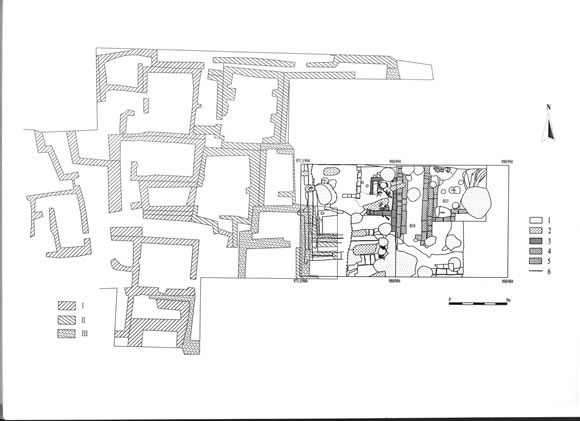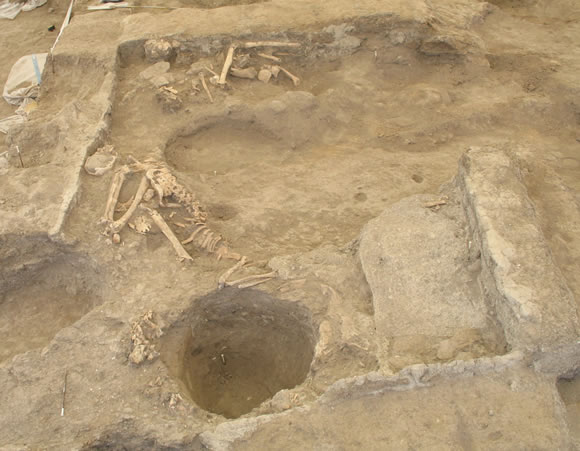THE TP EXCAVATIONS
Lech Czerniak and Arkadiusz Marciniak
The TP team (Team Poznan) team made of twelve archaeologists and students of the Institute of Prehistory, University of Poznan and the Institute of Archaeology and Ethnology, Polish Academy of Sciences in Poznan conducted its fifth field season at Çatalhöyük between July 7 and August 3, 2005. The excavations this year continued in an extension trench 5 by 10 meters on top of the East Mound, in a strip between the main TP trench excavated in previous seasons, and the east trench dug by Mellaart in the 1960s.
One of the major objectives of this season was to correlate walls and buildings in the TP area with those of Mellaart Area A from the 1960s to be able to relate excavated Neolithic structures to the Mellaart chronological scheme. This goal was satisfactorily achieved by analysing a sequence of mudbrick walls in the west sector of the excavated area. These were further identified on the Mellaart plans from his Anatolian Studies report published in 1962 as originating from Levels I and II (Figure 20). Consequently, after careful stratigraphic analysis of all deposits in the excavated trench, it proved possible to distinguish three late Neolithic phases corresponding to Levels 0, I and II according to the Mellaart scheme. All structures dated to Level 0 in the TP area were excavated in the 2005 season.

Figure 20. Plan of TP structures (east) overlaid on 1960s plan. |
This season also involved recognising and lifting the remaining elements of the late occupation phases of this part of the mound. These comprised five Byzantine burials (one adult and four infants), localised in the northern part of excavated area, in addition to twenty pits of different function including large storage pits as well as postholes and other unspecified features, most of them probably Hellenistic or Roman in date. A majority of them were discovered in the southern and western sections of the trench.
Figure 21. Up to six individuals (two infants and 4 adults) were found in the south part and three to four individuals (all adults) to the north of Space 248. on 1960s plan. |
In Level 0 a major discovery was a room recorded as Space 248. It is a rectangular structure 2.7 m long and 1.7 m wide. This room was probably used as a burial chamber as indicated by remains of at least six individuals (two infants and 4 adults) in its south part and three to four individuals (all adults) in the north (Figure 21). The south part of the space contained mostly disarticulated remains, predominantly skulls, while the north part was dominated by articulated skeletons. All these individuals or their remains were interred on the floor and then deliberately plastered. The bodies were buried in at least two episodes/phases, each of them marked by a layer of silty plaster.
Other discoveries of the 2005 season in the TP Area comprised elements of a late Neolithic building in the west section of the excavated area dated back to Level I. The building was rebuilt at least twice as indicated by two types of floor as well as a number of partition walls. Its overall shape and size have not yet been defined. The two-phased floor was built up on a white pebbly make-up layer, which is the first discovery of this kind at Çatalhöyük.
The season also led to the recognition of a number of solid mudbrick walls from Level II. They were found in the west and south part of the excavated area as well as at the bottom of cuts of older pits. The layout of these walls may tentatively suggest a size of building as being 9 meters long and 7 meters wide. The most straightforward stratigraphy was in the west section of the excavated trench, directly between the TP Area and the Mellaart trenches from the 1960s. Two walls from Level II, recorded as (12229) and (12230), were later replaced by a wall recorded as (11583) from Level I. No elements from this phase were excavated in this season.
